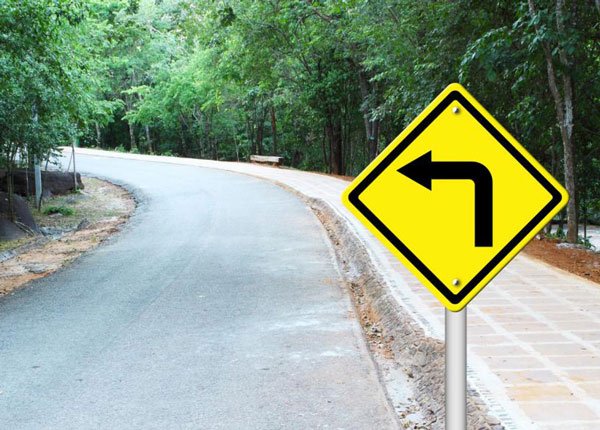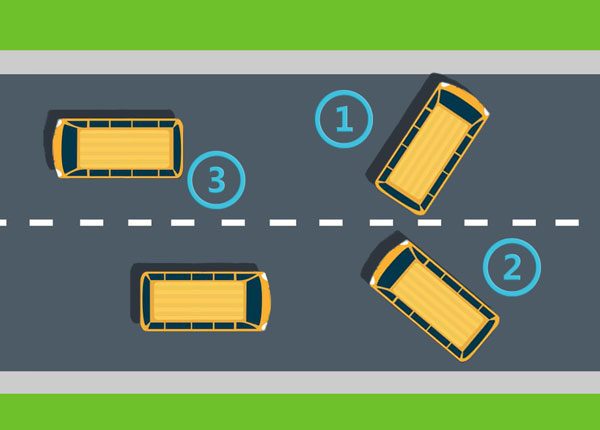
Turning Left: Hand Signals, Left Turn on Red, Center Left Turn Lane
Updated Oct. 30, 2020Turning left is riskier and demands more caution than turning right, because the turn will take you across the path of traffic which is traveling toward you, from the opposite direction. Of the roughly 2.5 million intersection collisions documented by the Federal Highway Administration (FHA) each year, most involve left turns.
Be sure to signal your intention to turn left as early as possible, while observing any right-of-way laws that are relevant to your situation. Drivers must also take particular care when turning left onto a street from an alley or driveway and learn how to use a center left-turn lane.
Making a left turn at an intersection
Follow these steps to make a left turn at an intersection:
- 1

Plan for your turn.
Map your journey ahead of time and keep an eye on the road ahead. You must choose the correct lane and assume the right position within that lane in advance of the left turn (i.e. the left side of the lane or lane position 2). Never make a last-minute left turn as you could present a hazard for other drivers. If you miss your turn, make a U-turn at the next available turn off and return to the intersection. - 2

Do not attempt to turn left if there is a “NO LEFT TURN” sign at the intersection.
- 3

Indicate your intention to turn left early.
If your turn signals are not working you may use a left turn hand signal by extending your left arm straight out of the driver’s window. Find guidance in your state driving manual regarding how soon you should signal. Most states require drivers to activate their turn signals 100 feet in advance of a turn, though some others ask for 200 feet. - 4

If there is a “STOP” sign at the intersection, you must bring your vehicle to a complete stop, allowing cross-traffic and pedestrians the right-of-way before executing the turn.
Where a “YIELD” sign is present you should slow down and yield the right-of-way, without coming to a complete stop unless the situation demands it. - 5

If traffic lights control the intersection, abide by signals.
Green arrow:
When a green, left-pointing arrow is present, you have the right-of-way and your left turn is protected. Any opposing traffic and pedestrians which may cross your path will be stopped by a red traffic light. Be sure to allow any vehicles and pedestrians who are already crossing the intersection time to pass before executing the left turn. When the arrow switches to yellow, the time in which you can make a protected left turn is about to end.
Solid green signal:
Drivers may turn left when a solid green signal is present but MUST yield to opposing traffic before doing so. This is even permitted at intersections where a green left-turn arrow is present but not active. Turning left under a solid green signal is known as an “unprotected left turn”. There may be a sign marked “LEFT TURN YIELD ON GREEN” to remind you of the turning protocol, though this is not guaranteed.
Solid red signal:
Turning under a solid red signal is prohibited. However, some states will permit drivers to turn left into a one-way street when a red signal is present. Check your state driver’s manual to find out whether this rule applies in your area. If the intersection is marked with a “NO TURN ON RED” or a “NO LEFT TURN ON RED” sign, you must not turn until the signal light has changed.
Red arrow:
Never turn left when a red left-pointing arrow is present. - 6

Complete your left turn when it is safe to do so.
Remain in the same lane throughout the turn as switching lanes at an intersection is not permitted in most states. Even where changing lanes at an intersection is not strictly illegal it may still land you with a traffic fine for dangerous driving. Be sure to avoid doing this during your practical driving test!
 A “No Left Turn” traffic sign prohibits left turns at an intersection. It is frequently posted at intersections with one-way streets, where turning left would place drivers in the position of going against traffic.
A “No Left Turn” traffic sign prohibits left turns at an intersection. It is frequently posted at intersections with one-way streets, where turning left would place drivers in the position of going against traffic. The correct procedure for making a left turn alters slightly is based on whether you are dealing with one-way or two-way streets..
From a one-way street into a one-way street:
You should start the maneuver from the lane furthest left, when turning left from a one-way street onto another one-way street. Complete the turn in the same lane. Turning left onto a one-way street is usually permitted when a solid red traffic signal is present – check your driver’s handbook for details. You may find that more than one lane is reserved for turning left at a one-way to one-way intersection. Signs and pavement markings will make this evident.
From a one-way street into a two-way street:
The same instructions as above apply when turning from a one-way street onto a two-way street. Though here, you should start in the far left lane and return to the lane nearest to the lane divider. Do not switch lanes on the intersection.
From a two-way street into a two-way street:
Begin the left turn in the furthest lane to the left, when turning left from a two-way street onto another two-way street. Remain in the same lane, taking care to yield to traffic and pedestrians if the left turn is unprotected. Turn without swinging your car wide as traffic traveling from the opposite direction may be turning left at the same time.
Left Turn on a Red Traffic Signal
When it comes to turning left on a red traffic signal, there is no standalone rule that tells you whether it is permitted. It is often allowed, though only when certain conditions are met. These conditions may vary state-by-state, so it is essential to read up on this issue in your driving manual. Most states permit left turns under a solid red signal when:
- The turn is from a one-way street, to another one-way street.
- There is no “NO TURN ON RED” sign present.
 Most states allow drivers to make left turns on red, unless a traffic sign prohibiting the maneuver is posted at the intersection. Drivers must stop and yield to all traffic and pedestrians before turning left on red signal.
Most states allow drivers to make left turns on red, unless a traffic sign prohibiting the maneuver is posted at the intersection. Drivers must stop and yield to all traffic and pedestrians before turning left on red signal.Center Left Turn Lane
Some intersections have a center left-turn lane which can be used by traffic moving in both directions. This is also known as a “two-way left-turn lane”. Center left-turn lanes allow drivers to turn left without holding up traffic that is traveling straight through the intersection.
Getting to grips with the rules concerning two-way left turn lanes is easy:
- Do not enter this lane too soon or for any reason other than to make a left turn. The permissible distance to travel in a left turn center lane is set at 200 to 400 feet, depending on the state.
- Never use the two-way left-turn lane to pass another vehicle.
- Drivers may use the center left-turn lane when turning left onto a road from a driveway or alley. Though, it must not be used as an acceleration lane.
- Only enter the center lane when it is clear of other vehicles and opposing traffic.




